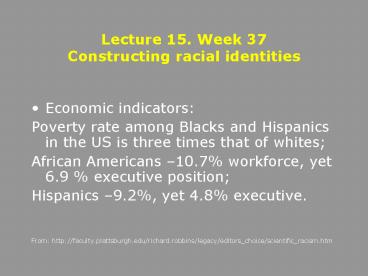Lecture 15. Week 37 Constructing racial identities - PowerPoint PPT Presentation
1 / 19
Title:
Lecture 15. Week 37 Constructing racial identities
Description:
Poverty rate among Blacks and Hispanics in the US is three times that of whites; ... early primitivism- evident in all colonial societies by the late 1600s ... – PowerPoint PPT presentation
Number of Views:73
Avg rating:3.0/5.0
Title: Lecture 15. Week 37 Constructing racial identities
1
Lecture 15. Week 37 Constructing racial
identities
- Economic indicators
- Poverty rate among Blacks and Hispanics in the US
is three times that of whites - African Americans 10.7 workforce, yet 6.9
executive position - Hispanics 9.2, yet 4.8 executive.
- From http//faculty.plattsburgh.edu/richard.robbi
ns/legacy/editors_choice/scientific_racism.htm
2
Anthropological ideas about race 1870-1920
anthropology identified itself as the study of
different races of mankind Anthropometric
studies Since then, efforts to critique the
notion of race as a biological concept
3
Anthropometric tools
4
Anthropometric measurements, 1890s, Masubia men
5
How is race defined?
- framework of ranked categories
- dividing human population into hierarchy of
races, colours, religions and cultures - developed by western Europeans following global
expansion, 1400s - Linguistic lineage of race
- word first appeared in 1580 to refer to a breed
or stock of animals - can be traced to the Arabic word ras and the
French word razza both meaning order or lineage - Spanish and Portuguese term raza has a similar
definition
6
Popular conceptions of race
- global
- small number of categories, most frequently just
three (white, black yellow (Caucasoid, Negroid,
Mongoloid (and then subgroups) - Assumed ranks of categories of cultural worth,
intelligence, attractiveness etc. - reinforces legally and politically economic and
social inequality - race seen as natural, biological, real and
unquestionable
7
cultural category rather than a biological
reality
- discredited biological term
- molecular biology and genetic studies
- plenty of genetic variation in humans, but 85 is
individual variation. - Humans- the most genetically homogenous species,
- no biological evidence of historical sublineages
of humanity
8
Classfication
Jeffrey Fish, Mixed Blood (2000). Avocados and
people Is avocado a fruit or a
vegetable? Question of classification - people
in with mixed blood In Brazil loura (whiter
than white) branca (white) morena (dark curly
hair, tan skin, nose not narrow, lips not thin)
mulata (tight curly hair, darker range of skin,
broad nose, thick lips). In America by drop of
blood no physical characteristics. In Russia
by physical appearance. Chechen people or look
alike are spotted by police.
9
The history and evolution of the notion of race
- race arose alongside the development European sea
travel after 1492 - 500 year old discussion about what constitutes
humans - 16th century imagined spaces based on medieval
geographies - Ideas of the other
10
cannibals
11
Amazon women
12
Image from Mandeville
13
Columbus discovers the New World, 1590
14
Nova Reperta- Vespucci awakens America, 1598
15
Early classifications, little to do with skin
colour
- at first, religious categories, barbarians and
natural slaves - Debates over the slavery of the Amerindians, how
to classify them (human or beast) early 1500s - History of the classificatory term barbarian
(Greeks, Aristotle, Spanish colonialists)
16
Ways to define barbarians, Indian savagery in the
New World
- cannibalism
- dietary norms
- technology
- lack of laws, arts, writing systems
- Great debates
- Environmental determinism
- 1537, officially decreed that Indians could
qualify for eternal salvation
17
St. Thomas of Aquinass adaptation of Aristotle's
Theory of Natural Slavery384-322 BC
- -axiom of Greek thought
- existing in all complex forms a duality (in which
one element naturally dominates the other)--
i.e.--intellect vs. emotion, rationality vs.
passions etc. - Natural slaves Indians and women
- men are creatures of their environment
- first employed in Spain, 1512
- early primitivism- evident in all colonial
societies by the late 1600s - in the 1700s, scientific frameworks (Western
Europe) place exploited peoples into natural
schemes, culminating in the division of mankind
into different races
18
Early 19th century anthropology
- polygenists vs. monogenists
- 1871 Darwin, The Descent of Man and Selection in
Relation to Sex - culture could only be as advanced as the brains
that produced it - Social Darwinists ---20th century Eugenics
movement
19
Anthropology and the construction of a Racial
Worldview
- Lewis Henry Morgan and EB Tylor
- rank human groups along unilinear evolutionary
path from savagery to civilization - Craniometric data
- Tylor Primitive Culture 1871
- doctrine of the psychic unity of mankind
- human nature universal baseline for cultural
development that has taken humanity from its
primitive, hunter-gatherer roots to modern
science and civilization































